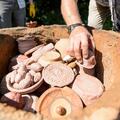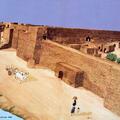Discarded ancient Indus sherds, after archaeologists have sifted through them and cleaned them. This pottery debris from excavations at Harappa covers hundreds - if not a thousand – years of habitation, far longer a period than say modern times.
344 posts, also carried on our Facebook page, about the ancient Indus Valley civilization, including important news, research and occasional visits to museums with ancient Indus artifacts.
Jul 29, 2016
A nice piece on students on replicating Harappan techniques in Wisconsin in 2016 with Mark Kenoyer shows how much we have to learn about the complexity of ancient manufacturing.
Jul 23, 2016
"Astronomy, including the use of a star calendar, played an important role in ancient Mesopotamia, and deeply influenced its religion: all the main gods were symbolized by particular stars or planets.
Jul 17, 2016
Lots if interesting stuff here, including "It had been widely assumed that these first farmers were from a single, genetically homogeneous population."
Jul 15, 2016
In connection with the recent post about Indus discoveries in Oman, we note that the archaeologist who discovered the first definitive evidence of Bronze Age trade between Balochistan and the Gulf, Beatrice de Cardi, just died at the age of 102.
She worked with Sir Mortimer Wheeler who lent her "his foreman, Sadar Din, a minor official of the Pakistani Archaeological Department who, despite being illiterate, had an extraordinarily retentive memory for archaeological sites and taught her what to look for. Together they located some 47 archaeological sites . . .."
Jul 14, 2016
One of the least explored avenues in ancient Indus research, one which would so clearly reinforce the available evidence for the long, deep local roots of Indus civilization stretching back deep into the Stone Age (25,000-30,000 years back).
Jul 13, 2016
"Much valuable information about the various indoor games indulged in by the Harappans is available from the gamesmen, game-boards and dices found at the major Indus cities.
Jul 5, 2016
"Late III Phase. Average level: – 9.9 ft. – A few walls only remained of House I, and it will be noticed that Fore Lane had been closed in by continuing the east wall of House I right across it to the northern wall of Block I on the opposite side.
Jun 26, 2016
Exciting new discoveries through 2015 at Salut tower in Oman show how extensive Indus trade and relationships with this area were during the Bronze Age (2500-2000 BCE).
Jun 11, 2016
1. A conjectural view of Indus settlement at Surkotada. Painting by Lalit Jain, Archaeological Survey of India. 2. One of the most detailed reconstructions of an ancient Indus gateway, this one on Mound E at Harappa.
Jun 9, 2016
Recent claims suggest that Rakigarhi is older (ca. 7000 BCE) than Mohenjo-daro.
May 30, 2016
An article by Andrew Lawler discusses how archaeologist Arunima Kashyap and Steve Weber at the Washington State University determined that curries - using garlic, ginger and turmeric - were prevalent in the Indus civilization. This was done by analyzing finds from Farmana and Harappa, using starch grain analysis and other methods.
May 30, 2016
A new article published in Nature argues that Bhirrana is one of the earliest Harappan sites in India and dates back to the 7th millennium BCE based on radiocarbon dating.
May 30, 2016
The Bengali filmmaker Satyajit Ray's book of short stories The Unicorn Expedition, the title story of which concerns Mohenjo-daro, includes another brilliant story which may also have connections to the ancient Indus civilization. It is called Night of the
May 28, 2016
"The bathroom itself was usually a small square or rectangular room with a carefully-laid brick pavement sloping towards one corner. In this corner was the outlet for the water, which, in some cases also ran through the latrine."















